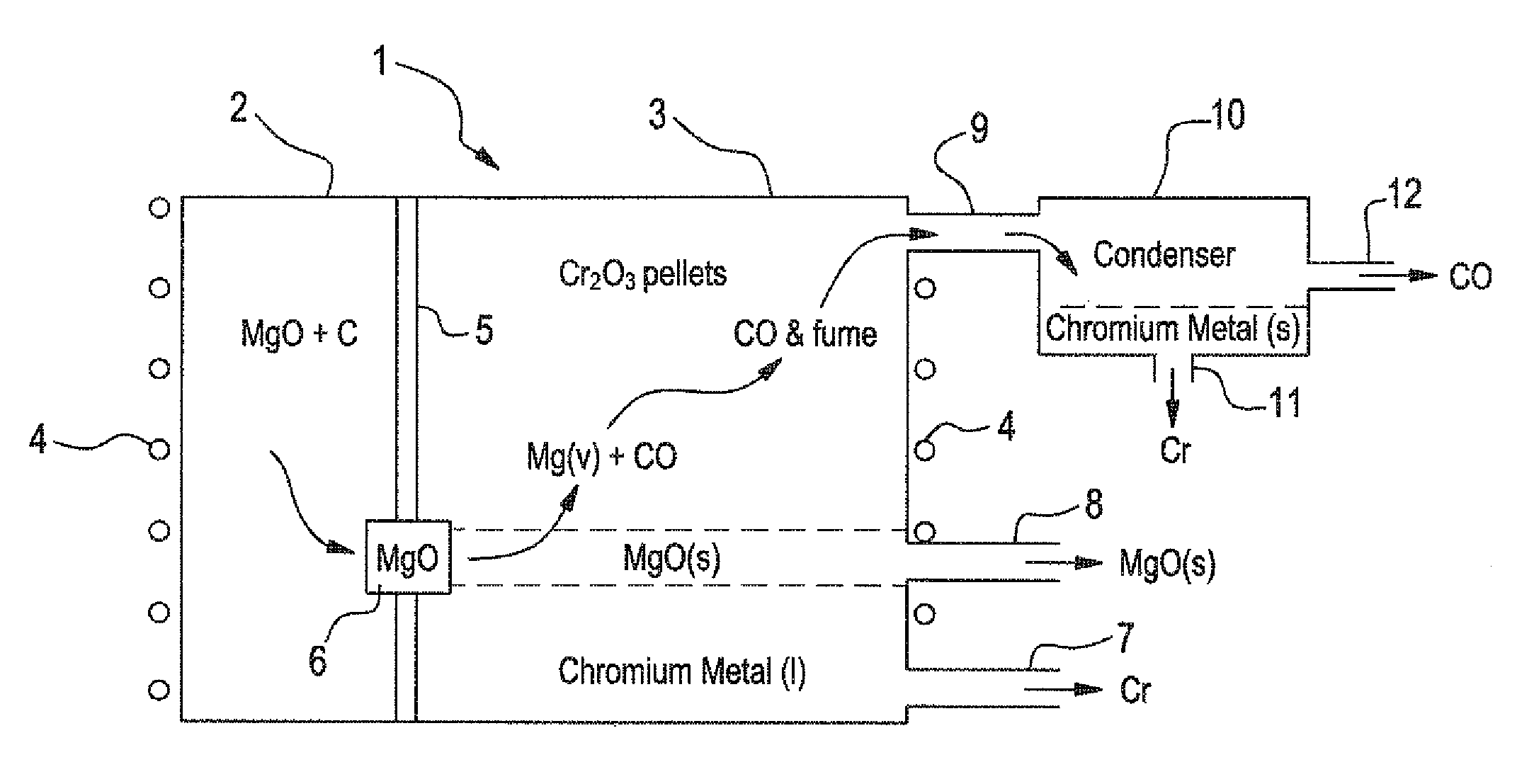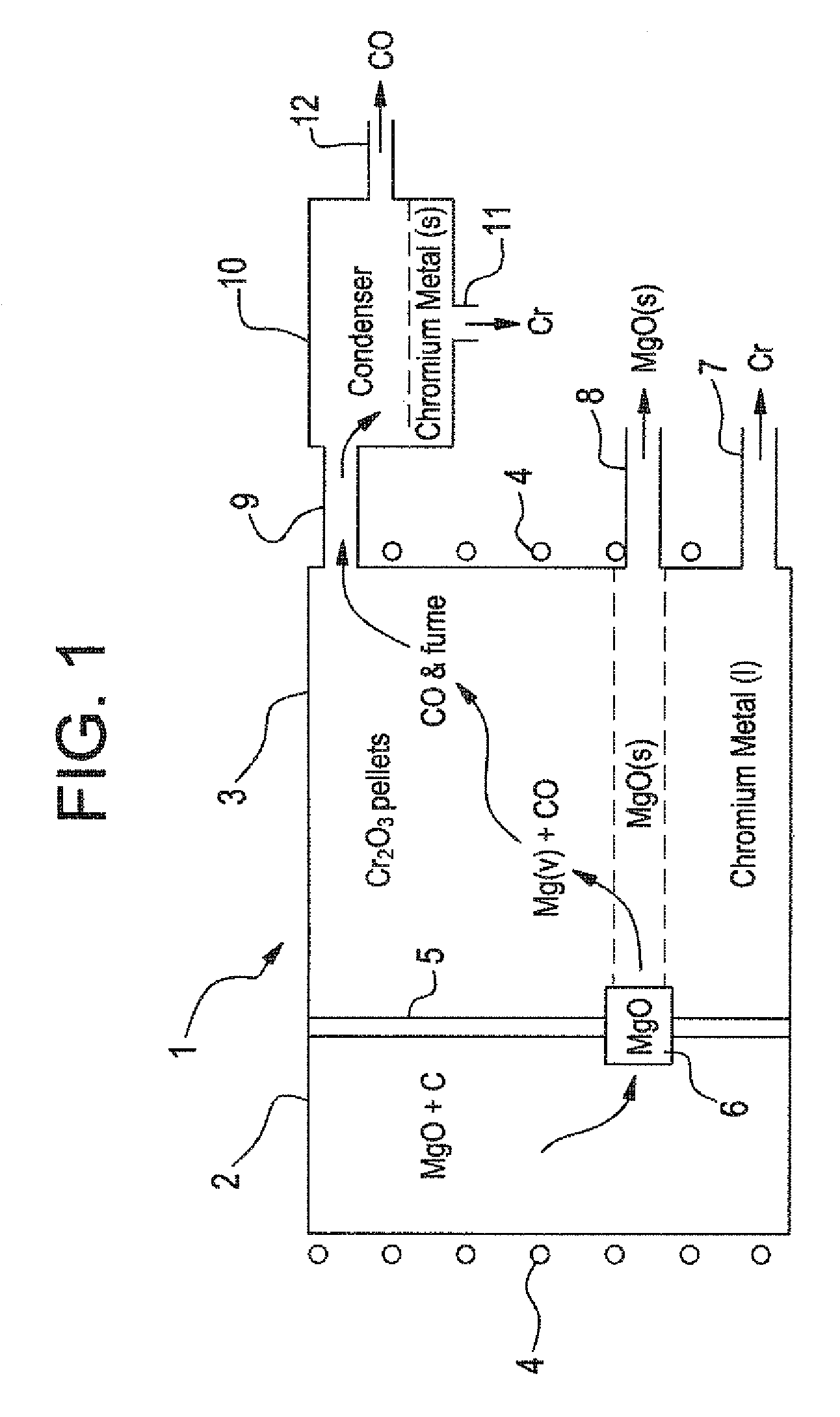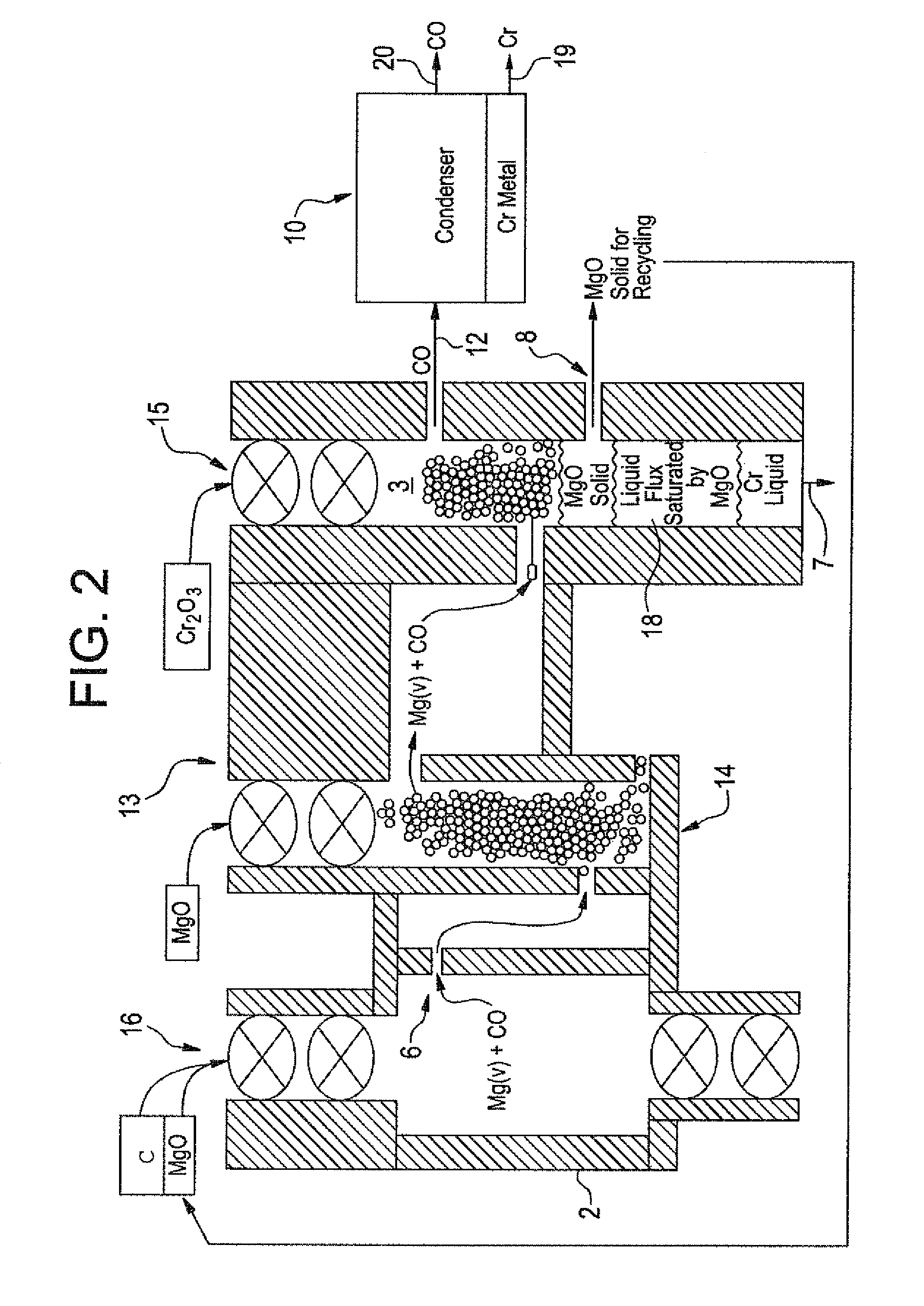Method and apparatus for high temperature production of metals
a high-temperature production, metal technology, applied in the field of high-temperature production of metals, can solve the problems of complex method, large-scale exposure of magnesium powder, and raised environmental problems, and achieve the effect of simple and efficient manner
- Summary
- Abstract
- Description
- Claims
- Application Information
AI Technical Summary
Benefits of technology
Problems solved by technology
Method used
Image
Examples
example 1
[0045]In the method schematically illustrated in FIGS. 1 and 2, very-low carbon chromium metal is produced. In the process of this invention, gaseous Mg / CO mixture is produced in first chamber 2 following the formula:
3MgO(c)+3C at 2200° K yields 3Mg(g)+3CO(g).
This gaseous product, without any free C, is passed over Cr2O3 in second chamber 3, for reduction of Cr2O3 in accordance with:
3Mg(g)+3CO(g)+Cr2O3(c) at 2200° K yields 3MgO(c)+2Cr(l)+3CO(g)
The Gibbs Free Energy values for this reaction are
0+−908 KJ / mol+−562 KJ / mol - - - yields −839 KJ / mol+0+−908 KJ / mol
Or, by viewing the gaseous CO as an inert gas at 2200° K,
−562 KJ / mol - - - yields −839 KJ / mol (Gibbs Free Energies).
The overall negative Gibbs Free Energy favors reduction of Cr2O3 to chromium so that the chromium liquid is tapped out from below. The magnesium oxide crystals can be periodically cleaned of any adherent chromium by vacuum removal of the chromium because its vapor pressure is substantially higher than the magnesium ox...
example 2
[0051]The method of the present invention can also be used in the production of very-low carbon manganese using the batch process of FIG. 1 or a continuous reactor 13 as shown in FIG. 3. As before, gaseous Mg / CO mixture is produced by carbothermic reduction of MgO in first chamber 2,
MgO(c)+C(c) at 2200° K yields Mg(g)+CO(g)
The resulting gaseous Mg / CO mixture is filtered to remove free C, is passed through a MgO fed filter 14 into second reaction chamber 3 to react with MnO (the resulting oxide from heating Mn3O4) supplied by feed mechanism 15 into second chamber 3 at 2200° K
Mg(g)+CO(g)+MnO(c or l) at 2200° K yields MgO(c)+Mn(l or g)+CO(g)
The Gibbs Free Energy values are
0+−303 KJ / mol+−213 KJ / mol - - - yields −280 KJ / mol+0+−303 KJ / mol
Or, by viewing the gaseous CO as an inert gas at 2200° K
−213 KJ / mol - - - yields −280 KJ / mol
The MnO at 2200° K is just below the boiling point of Mn. Mn(g) at 2200° K has a Gibbs Free Energy of +13 KJ / mol. In the batch process some of the Mn as liquid can...
example 3
[0056]The method of the present invention can further be used to produce zinc and zinc alloys. In the process of this invention, the carbothermic magnesium products around 2200° K are again used.
MgO(c)+CO(c) at 2200° K yields Mg(g)+CO(g)
The gaseous Mg / CO mixture is passed over ZnS so that
Mg(g)+CO(g)+ZnS(l) at 2200° K yields MgS(c)+CO+Zn(g)
The Zn is condensed from the CO quickly to prevent a back-reaction between the Zn and CO, or, as employed in the Imperial Smelting Furnace method, condensed into a spray of molten lead and distilled out later.
[0057]The MgS can be roasted or treated with an oxygen compound such as steam to convert the Mg entity back to MgO. If steam is used,
MgS(c)+H2O(g) at 1800° K yields MgO+H2S(g) with Gibbs Free Energy of:
−194 KJ / mol+−147 KJ / mol - - - yields −361 KJ / mol+−1 KJ / mol
The H2S can then be subjected to the Claus Process, currently the main process used to generate elemental sulfur from H2S found in natural gas, 2H2S(g)+O2(g) to yield 2 S2+2H2O. The MgO i...
PUM
| Property | Measurement | Unit |
|---|---|---|
| temperatures | aaaaa | aaaaa |
| temperature | aaaaa | aaaaa |
| temperature | aaaaa | aaaaa |
Abstract
Description
Claims
Application Information
 Login to View More
Login to View More - R&D
- Intellectual Property
- Life Sciences
- Materials
- Tech Scout
- Unparalleled Data Quality
- Higher Quality Content
- 60% Fewer Hallucinations
Browse by: Latest US Patents, China's latest patents, Technical Efficacy Thesaurus, Application Domain, Technology Topic, Popular Technical Reports.
© 2025 PatSnap. All rights reserved.Legal|Privacy policy|Modern Slavery Act Transparency Statement|Sitemap|About US| Contact US: help@patsnap.com



